
Festivals in Nepal
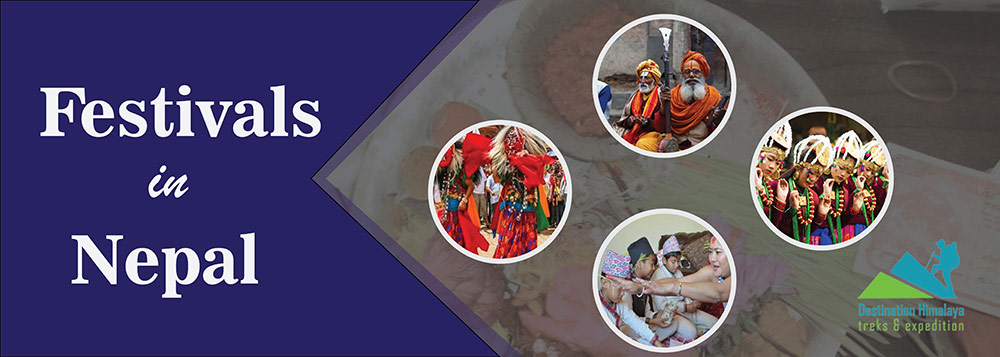
Festivals in Nepal
Nepal is a South Asian nation that is small and landlocked. The country is widely popular as a ‘trekkers’ paradise’ for trekking and expedition in the vicinity of the world’s highest Mt. Everest and other several snow-capped mountains. Nepal’s introduction around the globe is only limited to mountaineering and trekking. Despite being a small nation, Nepal is diverse in terms of nature, geography, culture, tradition, ethnicity, language, and religion. Many people might find it surprising to know that Nepal has 124 languages, 142 ethnic groups, and 10 religions. Nepal is a multi-cultural and multi-linguistic country. All people respect each other’s culture, tradition, religion, and language. There is unity in diversity.
Nepal is also popular for its cultural attractions. The different ethnicity in the different regions of Nepal celebrates numerous festivals. Nepal is one of such nations in the world, where a maximum number of festivals are celebrated throughout the year. All festivals are unique and hold great historic and cultural importance. Many festivals are organized around the popular cultural heritages to pay respect to and preserve the cultural beliefs and rituals. For Nepalese, not only World Heritages sites but all other temples, monuments, and stupas are considered cultural heritages. The festivals are organized and celebrated grandly. Most of the festivals in Nepal are celebrated according to the Nepali months and Nepal Sambat of the lunar calendar. Hence, the festive dates and months may differ from the Western calendar. There are many festivals in Nepal but we have listed below some widely popular festivals:
Dashain –Auspicious & Longest festival
Dashain is the most anticipated Hindu festival which lasts for 15 days. Thus, it is the longest and most auspicious festival in Nepal. Not only Hindus, but Newar Buddhists in Nepal also celebrate Dashain as ‘Mohani’ with great joy. Dashain marks the celebration of victory over bad/evil. The 1st {Ghatasthapana}, 7th {Phulpati} 8th {Maha Asthami}, 9th {Maha Navami}, 10th {Vijaya Dashami}, & 15th {Kojagrat Purnima} days of Dashain are the most significant. For 9 days, Navaratri is celebrated by performing various rites and rituals and visiting Shaktipeeths of Goddess Durga. The Navaratri begins on the first day of Dashain i.e. Ghatasthapana. On this day, in an earthen pot holy ‘jamara’ (barley grass) seed is planted in holy water with a mix of other special seeds. On the 10th day, which is called ‘Vijaya Dashami’, the family members put a tika on their forehead, jamara plant from the hand of elders, and take blessings. Newari people put red tika, jamara, and a special black tika called ‘Mohani shinha’ on their forehead and red thread on their necks. The festival is celebrated with great enjoyment and happiness with all family members as all are gathered in one place. A great occasion for meeting family members, relatives, and friends. People enjoy flying kites, eating delicious food items, gathering family members, playing a swing, and cards for fun, and visiting temples.
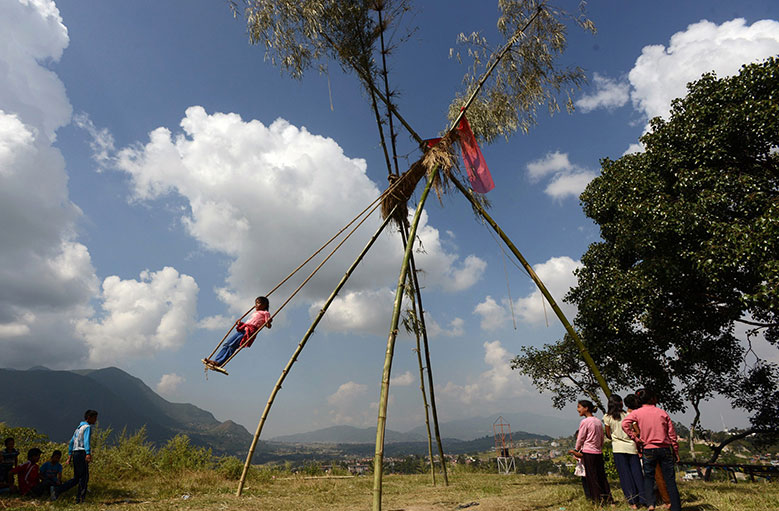
Start month: Pratipada of Shukla Paksha (1st day of a waxing moon) of Asoj/Ashwin [Sep/Oct]
End month: Purnima (15th day of bright full moon night) [Sep/Oct]
Tihar- Festivals of Lights
Tihar is the second most famous festival in Nepal celebrated by Hindus and other ethnicities in Nepal. It is also called Yamapanchak, Deepawali, and Sunti (by Newars). Each day in this 5-day festival has great importance. The festivals celebrated in Nepal are not only for gods but also for nature, animals, and birds. The 1st day of Tihar is Kaag (Crow/Raven) Tihar. Kaag is believed to be the vehicle/messenger of Yama (God of death). On this day, grains, and seeds are offered to the crows on the roof or streets and worshipped them.
The 2nd day is Kukur (Dog) Tihar. Newars called it Khicha Puja. The dogs are worshipped, put a tika and garland over their neck, and fed with food items and sweets.
The 3rd day is Gai (Cow) Tihar and Laxmi Puja. In the morning, the cows are worshipped with garlands, and tika (red vermillion). Hindus considered the cow as the vahana (vehicle) of Goddess Laxmi. Thus, it is a sin to kill and eat cows in Nepal. In the evening, Laxmi Puja is performed by worshipping Goddess Laxmi (wealth goddess). Goddess Laxmi is decorated with electric lights and garlands, and the house is kept clean to please Goddess Laxmi. Special sweets and fruits are offered to Goddess Laxmi. The whole house is lit with diyas (clay/mud oil lamps with a cotton wick in them). This is the reason Tihar is called the ‘Festival of Lights.’ The whole street looks vibrant due to the lit diyas in the houses and the electric lights on the streets.
The 4th day is Govardhan Puja and Mha Puja. On this day, the goru (ox) is worshipped with a red tika on the forehead, garland on the neck, and offered various food items to them. It is also called Hali Tihar and Goru Tihar. The idol of Govardhan Mountain is made from cow dung and it is also worshipped. In the Newar community, with all family members in the evening, Mha Puja is celebrated. A unique festival to worship one’s body and inner soul. This also marks the first day of the Nepal Sambat calendar and is celebrated as a Newari New Year called Nhu:Daya: Bhintuna. Different rallies are organized and circumbation starts from and ends at Basantapur Durbar Square.
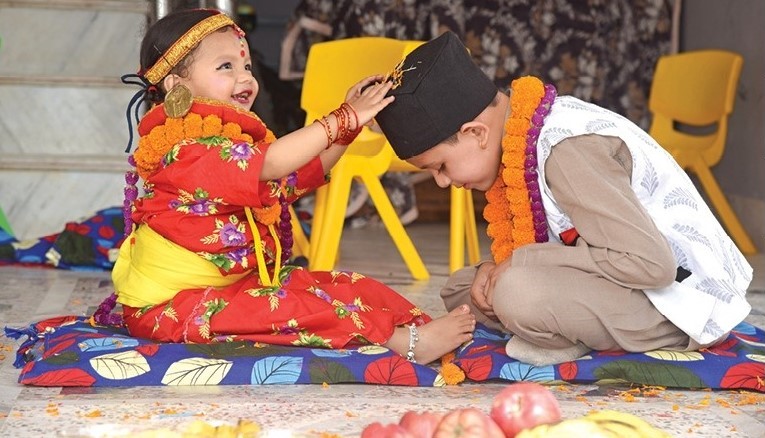
The 5th or final day of Tihar is Bhai Tika. Newar people called it Kija (brother) Puja. The special day, when the sisters put a saptarangi (7-color tika), or a red tika on the forehead of the brothers. The special garland is made with a special flower called Makhmali (Gomphrena Globosa). It is put on their neck and brothers seek blessings from sisters and give them gifts. Bhai Tika is celebrated by sisters for the longevity of their brothers. A festival to witness a strong bond between brothers and sisters.
In this 5-day festival, deusi- bhailo is also played by boys and girls where they sing and dance around peoples’ houses and enjoy.
Start month: Trayodashi of Kartik Krishna Paksha (13th day of a waning moon) [Oct/Nov]
End month: Dwitiya of Kartik Shukla Paksha (2nd day of a waxing moon) [Oct/Nov]
Buddha Jayanti- Birthday, Enlightenment & Maha Parinirvana of Gautam Buddha
Buddha Jayanti marks the birthday of Lord Buddha in Nepal. It is also called Buddha Purnima, Baisakh Purnima, Vesak, and Swaya Punhi (by Newars). Buddha Jayanti is celebrated in Lumbini (birthplace of Lord Buddha) in a grandeur manner. Many programs are organized in various sites of Nepal like Lumbini, Swayambhunath, Boudhanath, Namo Buddha, and other Buddhist monasteries, and Vihar. Many devotees from Nepal and outside the nation attend this festival with great happiness and excitement. The special dish Kheer (sweet rice pudding) is served to the devotees and visitors at these places. The butter lamp is lit around the places, Buddhist flags are decorated, and sermons on Lord Buddha’s teachings are preached by preachers. Buddha Jayanti is significant not only because of his birthday but also due to his attainment of enlightenment, and Maha Parinirvana. The Thrice blessed festival is celebrated with full devotion and happiness.
Buddha Jayanti Month: Baisakh Shukla Purnima (15th day of full moon night) [Apr/May]
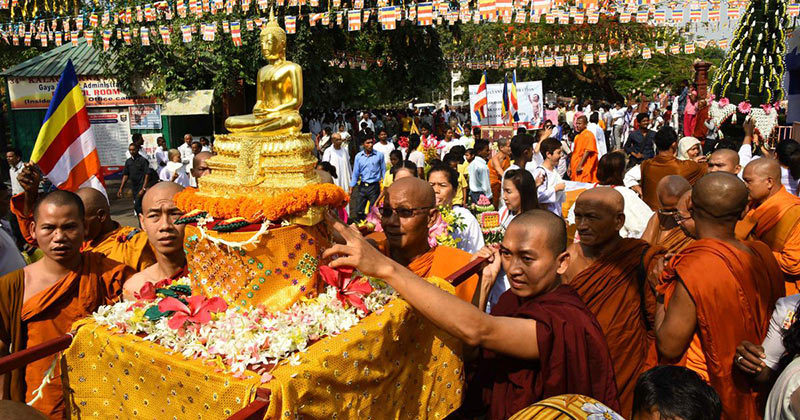
Maha Shivaratri- Festival of Lord Shiva
Maha Shivaratri is one of the greatest Hindu festivals in Nepal. This festival is dedicated to Lord Shiva. There are several tales related to Shivaratri. One is that Shivaratri marks the wedding anniversary of Lord Shiva and Mata Parbati. Another is, it is the night when Lord Shiva performed the Tandava dance. Another tale reveals it is the union of Shiva and Shakti to balance the world. Whatever the tales be, Maha Shivaratri is an auspicious and grand festival night devoted to Lord Shiva. The sacred Pashupatinath temple is crowded with millions of devotees from around the world to worship Lord Shiva. Thousands of Sadhu Baba visit Pashupatinath from India. On this day, devotees take a bath in the holy Bagmati River. They offer Bael Patra (leaves of golden apple), a paste of sandalwood, dhaturo (devil’s trumpet flower), fruits, and milk to the Shiva Lingam (phallus) and worshipped the Shiva Lingam. Besides this, devotees observe night-long fasting, participate in Maha Aarti and Puja, chant Shiva stotrams (hymn of praise) &mantras, dance, sing, and listen to the tales of Lord Shiva. Not only in Pashupatinath but all Shiva temples in Nepal celebrate Shivaratri with great dedication. In many places, a bonfire is set up and people distribute halwa (semolina/flour pudding) and puri (deep fry bread) as a Prasad (food offering to God). Married women pray to Lord Shiva for the longevity of their husbands. Unmarried women also worship Lord Shiva to be blessed with a husband like Lord Shiva as he is considered an ideal.
Maha Shivaratri Month: Magh/Falgun Krishna Paksha Chaturdashi (14th day of a waning moon) [Feb/Mar]
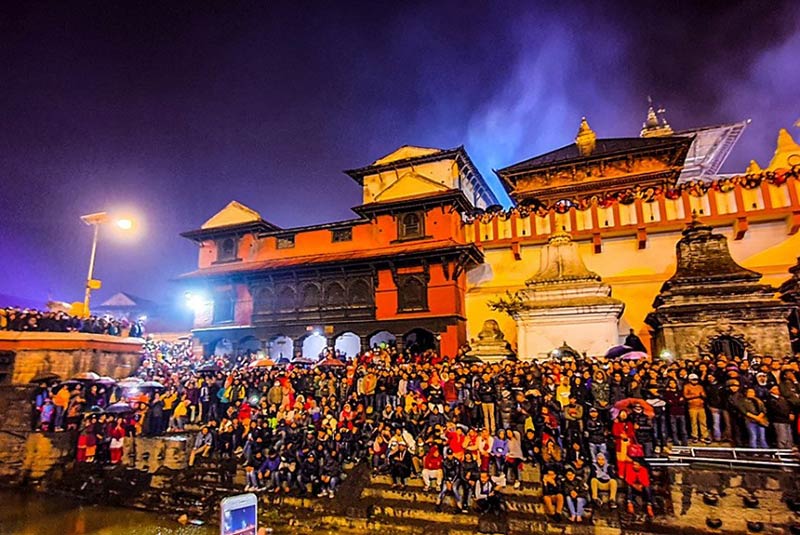
Rato Machhindranath Jatra- Longest chariot festival
Rato Machhindranath Jatra is the longest chariot festival held in Patan, (Lalitpur) of Nepal. In Newar Buddhism, Rato Macchindranath is called ‘Bung Dya:’, ‘Karunamaya’, or ‘Avalokiteshwara’. In Nepal Bhasha, this Jatra is called Bung Dya: Jatra. According to ancient tales, Kathmandu Valley suffered a drought of rain & rice grains for a very long time. With the help of the King of Bhaktapur, a priest of Kathmandu, and a farmer of Patan, they were able to bring Rato Machhindranath to the valley. When Rato Machhindranath was brought inside the valley, heavy rainfall occurred. Thus, it is considered the ‘Protector of the Valley’. Rato Machhindranth is the ‘deity of grains’. The deity is called Rato Machhindranath as its color is Red i.e. Rato. To mark the end of the long drought, the arrival of Rato Machhindranath, and grains implantation for harvesting, then King Narendra Dev started the Jatra/festival through the procession of a chariot.
The Jyapu (Newar ethnics) community of Lalitpur organized a grand chariot festival that lasts for a month. It takes 14 days to build a chariot and the remaining days for the chariot procession throughout the streets of Patan. With the help of a 60-foot-tall linga, the chariot is built. The 9-storied chariot is set up on 4 wooden wheels which symbolize four figures of Bhairab and is 32 hands long. The chariot procession commences after the installation of the image of Bung Dya: from his temple. The Bodhisattva idol ‘Chakuwa Dya:’ is installed in another chariot that accompanies the Bung Dya: chariot. The chariot procession begins at Pulchok and ends at Jawalakhel. The festival is accomplished with the ‘Bhoto Jatra’. Bhoto is a traditional vest that is displayed on the auspicious date fixed by astrologers in the Rato Machhindranath Jatra. In Nepal Bhasha, it is known as ‘Pwaakla Jatra’. After the Jatra is ended, the chariot is dismantled and kept in a safe place for the next year. The Rato Machhindranath is then taken to its second home in the Bungmati village where he stays there for 6 months.
Rato Machhindranath Jatra month: 4th day of the bright moon night, tithi Baachhala (7th month of Nepal Sambat), falls in Chaitra/Baisakh [Apr/May]
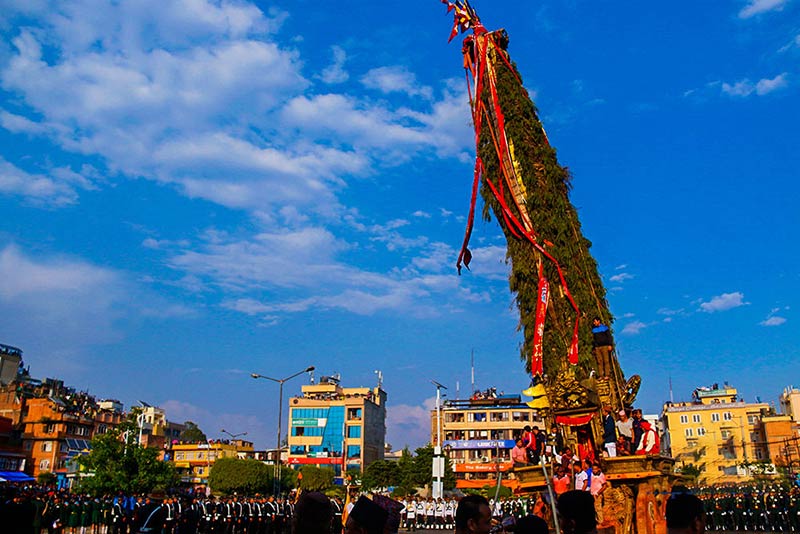
Chhath- Solar deity (Sun) Festival
Chhath is a festival dedicated to the solar deity ‘Sun’. The sun is very important to nature. Sun provides us with light, energy, good health, and longevity. Besides Sun, his sister Chhathi Maiya/Maata is also worshipped. The Maata is believed to be the protector of children from diseases and health issues and blesses them with good health, and long lives. The festival is observed for 4 days in the eastern part of the Terai region (Janakpur Dham, Ganga Sagar, Dhanush Sagar), some places in Kathmandu (Rani Pokhari, Kamal Pokhari, Bagmati river), and some parts of Birgunj and Biratnagar. The devotees take a ritual bath on holy rivers, keep fasting, and offer prayers and Surya Namaskar to the sun in dawn and dusk to the rising and setting sun. Chhath is celebrated two times a year. The 4 days are celebrated with 4 major steps.
Day 1- Nahay Khay: A holy bath is taken in the early morning and in a cleaned house Sattvik Kaduaa Bhaat (bottle gourd, Bengal gram lentil with Arva rice) is prepared. In the afternoon, the food is served as Bhog which is the last meal of the day.
Day 2- Kharna/Lohanda: The devotees spend the whole day fasting abstaining from water and food. In the evening, they end the fast by eating Rasiaav made up of gud kheer (sweet rice pudding from jaggery) with roti (bread).
Day 3- Sandhya Argha: In the morning, Thekuwa and Rice Laddoo Prasads are prepared. In the evening, Sandhya Argha is performed by worshipping the Sun and Chhathi Maiya in the river banks, ponds, or water bodies with Prasad and sprinkling Gangajal (holy water). Vrata Katha is read and Chaithi songs are sung at the night. After returning home, the Kosi Bharai ritual is performed with family members. A mandap is prepared by tying some sugarcanes and beneath it, 12-24 diyas are lit and Prasad and fruits are offered to it.
Day 4- Usha Argha:
Chhath Puja accomplishes with the Usha Argha. The Kosi Bharai ritual is performed in the early morning between 3 am – 4 am. After that, the devotees offer argha to the rising sun at the river bank, ponds, or water bodies. The devotees drink water and eat Prasad after the worship. Chhath puja ends with a belief in good health and long life blessings from the Sun and Chhathi Maiya.
Start month: Kartik Shukla Chaturthi (4th day of a waxing moon [Oct/Nov]
End month: Kartik Shukla Saptami (7th day of a waxing moon) [Oct/Nov]
Chaiti Chhath start: Chaitra Shukla Khasti (6th day of a waxing moon) [Mar/Apr]
Chaiti Chhath end: Chaitra Shukla Navami (9th day of a waxing moon) [Mar/Apr]
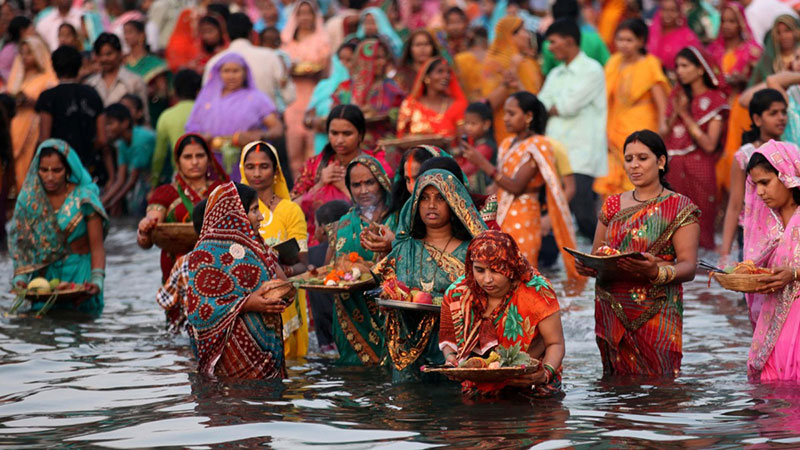
Lhosar-Tibetan New Year
Lhosar is a festival celebrated by different Tibetan communities in Nepal. Lho means year and Sar means new. Hence, Lhosar means ‘New Year’. The festival is celebrated with great enjoyment and with loved ones and near ones. People wear traditional dresses, perform various cultural dances, plays traditional instruments & music, sing a song, gather with families, consume the traditional drink ‘Changkol’(Tibetan rice beer), and cook & eat a special dish ‘Khapsey’(deep-fried biscuit), exchange wishes & gifts, and offer special drinks and foods to deities. The houses are kept clean & decorated, visit monasteries, and prepare khapsey and changkol. Lhosar is a great festival that displays true authentic Tibetan culture and Buddhism values to the world.
In the context of Nepal, there are three types of Lhosar celebrations. The Gurung community celebrates Tamu Lhosar. The Tamang and Yolmo communities celebrate Sonam Lhosar. The Tibetan and Sherpa communities observe Gyalpo/Gyalbo Lhosar which lasts for two weeks.
Lhosar months:
Tamu Lhosar: Poush 15 [Dec/Jan]
Sonam Lhosar: Magh Shukla Pratipada (1st day of a waxing moon) [Jan]
Gyalpo Lhosar (for 2 weeks): Falgun Shukla Pratipada (1st day of a waxing moon) [Mar]
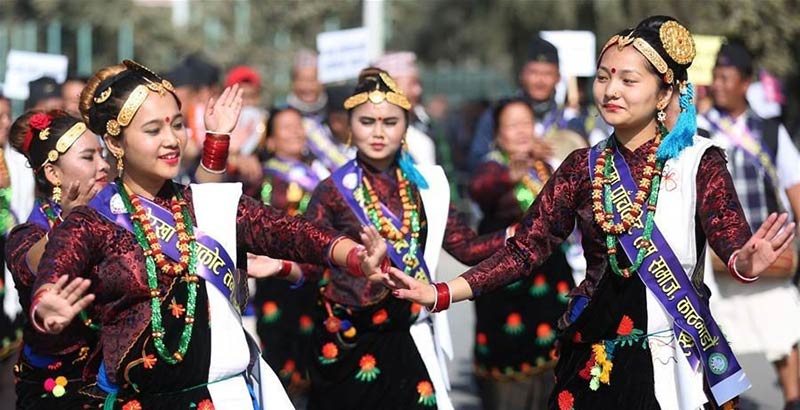
Indra Jatra
Indra Jatra is one of the historic significant festivals in Kathmandu. The Newars called it ‘Yenya’ which means the Kathmandu celebration. The 8-day-long festival is dedicated to the God of rain and harvest, Indra. Indradhoj Lingam also called Ya-Shee in Nepal Bhasha is set up in Basantapur, Kathmandu Durbar Square on the first day. A holy ceremonial pole is brought from the Nala forest, Bhaktapur. Upaagu Wanegu is another event performed on the first day. Newar community circulates around the major streets of Kathmandu city in the evening. They light incense and diya to pay respect to the deceased family members. The festival exhibits diverse cultures in various forms. The different images of Bhairavas (Shwet, Aakash, Baka) are displayed on different streets of the city. The 10 incarnations of Lord Vishnu and images of the deity Indra are also displayed for 8 days. Various masked dances & lakhey dances (Pulu Kishi, Majipa Lakhey, Sawa Bhakku) and dances (Devi Pyakha, Mahakali Pyakha) are major attractions of Indra Jatra. During Indra Jatra, the Jatra of the ‘Living Goddess Kumari’ is also observed. Kumari Jatra is celebrated by carrying the Living Goddess Kumari accompanied by a child representation of Bhairava and Ganesh in three different chariots. The chariot procession takes place for 3 days around the city of Kathmandu. Throughout the chariot procession, various musical bands play traditional music and musical instruments. Indra Jatra festival is observed by the President, Prime Minister, high-level ministers, mayors, and foreign diplomats of Nepal from the Gaddi Baithak, Hanuman Dhoka Palace. The festival ends with the taking down of a ceremonial pole on the 8th day.
Start month: Bhadra Shukla Dwadashi (12th day of a bright moon night), tithi Yanla {11th month of Nepal Sambat} [Aug/Sep]
End month: Bhadra Krishna Chaturthi (4th day of the dark moon night), tithi Yanla (11th month of Nepal Sambat) [Aug/Sep]
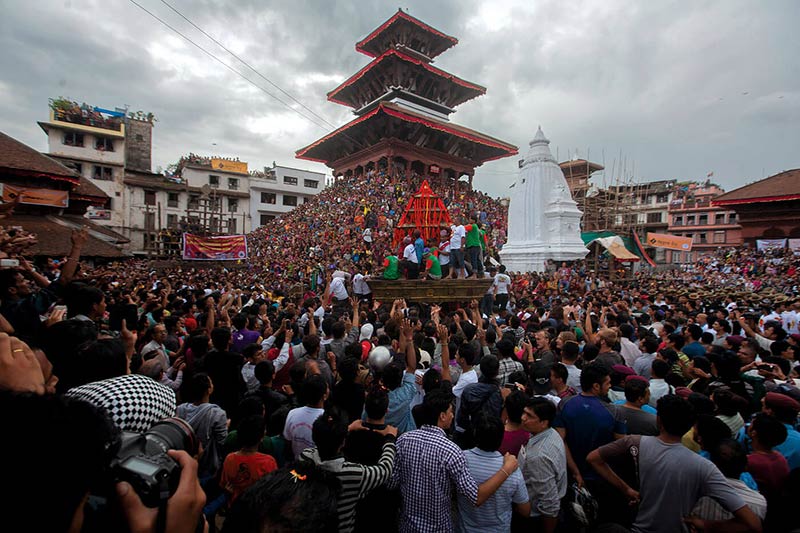
Maghe Sankranti
Maghe Sankranti also called Makar Sankranti is the festival that marks the end of the winter solstice. The warm and longer days with a new beginning to carry out auspicious events. The festival is dedicated to the Sun deity and is worshipped with great devotion. The sun symbolizes life, energy, power, positivity, clarity, confidence, and wisdom. People perform Makar Snan (holy baths) in the holy rivers of Nepal. Dolalghat, Baraha Kshetra, Ridi, Trivenighat, and Shankhamul are some places in Nepal where people take a bath on the bank of a river. At various river banks, fairs are held. The different communities celebrate Maghe Sankranti with great excitement. A fair is organized at the Til Madhav Narayan Temple at Taumadhi Tole, Bhaktapur, and tourists and crowds gathered to celebrate it. In the Terai region of Nepal, it is a post-harvest celebration. Newar community called it Ghya: Chaaku Sanhu. From the hands of elders, juniors apply lukewarm edible oil on their heads and seek blessings. Tharu community called it Maghi which is also the Tharu New Year. They observe grand festivals for 5 days which include wearing traditional dresses, dance, music, food, and liquors. The Magar and Kirat community also observes Makar Sankranti and celebrate it by performing their culture and traditions. The main dish of this festival is ghee, molasses, yams, sweet potatoes, cassava, and khichdi (rice mixed with black lentils and some spices). These food items are healthy and have high nutritional values which are good for the immunity of the body.
Maghe Sankranti month: Magh 1st [Jan]
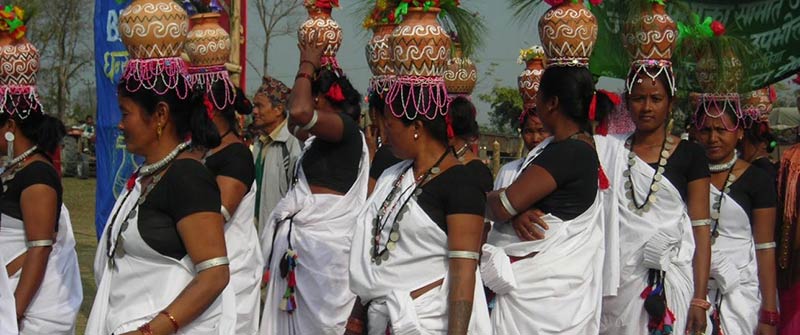
Holi-Festivals of colors, love, & spring
Holi is the festival of colors and love. It marks the beginning of spring in Nepal. This colorful festival is vibrant and full of enjoyment. Holi is also called Hori, Phagu, and Phaguwa. The auspicious festival is the victory of good over evil. Many tales are associated with this festival. As per Hindu tales, the celestial love of Lord Krishna and Radha symbolizes Holi. On the other hand, Holika got killed (aunt of Lord Vishnu’s devotee Prahlad). Holika Dahan is performed in front of a bonfire to mark the end of evil doings. In the context of Nepal, different ethnic communities celebrate Holi according to their culture and traditions. People celebrate this festival with their near and dear ones by applying colors on their faces and splashing water & balloons. Many tourists also attend this festival and enjoy it wholeheartedly. The different colors used in Holi are believed to take away sorrow and make life colorful. Holi celebration in Nepal takes place for two days. In the Hilly region, the Holi celebration takes place first. The next day, Holi takes place in the Terai region. In Kathmandu, Basantapur Durbar Square is the happening place for Holi. The Holi festival is organized on a huge scale. Many people, especially youngsters and tourists attend the festival here.
As the belief of the Newar community, on the Phalgun Shukla Ashtami (8th day of a bright moon night) Chir gaadne (set up) process is done. ‘The Chir’ symbolizes prosperity and is auspicious. With the help of the Nepal Army, the Manandhar ethnics bring a 6-inch thick and 32-foot long bamboo pole from a forest. Then, the three-tier umbrella-like structure is positioned on top of the pole which is decorated with pitambar (yellow cloth). A branch of dhaale {pomegranate or mayal tree (Pyrus pashia)} is brought from the Guheswori forest and set up on the umbrella at an auspicious time. The festival ends by taking down Chir in the evening and burning in the Tundikhel.
Holi month (Hilly region): Phalgun Shukla Chaturdashi (14th day of a bright moon night) [Mar]
Holi month (Terai region): Phalgun Shukla Purnima (15th day of a bright moon night) [Mar]

Bisket Jatra- Chariot festival in Bhaktapur
Bisket Jatra is the popular chariot festival in Bhaktapur which lasts for 8/9 days. This festival holds great historic and cultural significance in the city. Hence, it is celebrated with high values and follows all cultures and traditions ritually. As per ancient tales, two serpents came to kill a prince. But the prince found a way to kill the serpents. He killed the serpents with twenty cuts. Hence, this festival is celebrated to mark the victory. People celebrate this festival with great value, and happiness, and with full dedication in Madhyapur Thimi, and the streets of Bhaktapur. The local Newars of the city celebrate this festival on the first day of the Nepali New Year. Bisket Jatra is derived from the Nepal Bhasha ‘Bi’ and ‘Syaku’ meaning ‘snake laughter’. It is also called ‘Bisayu Jatra’ and ‘Biska Jatra’. The locals construct a 55-hand-long pole and two chariots of Bhairava and Bhadrakali. Then, 8 ropes are tied in a chariot to pull which symbolizes Astamatrikas (8 Goddess) and the symbol of 2 snakes. During these 8/9 days, different activities and parts of festivals are taken place. Shatruhanta Jatra (Rise & fall of Lyo Sin Dya or Lingo), chariot procession in the streets of Bhaktapur, Sindoor Jatra (orange vermillion) in Madhyapur Thimi, Jibro Chhedne Jatra (tongue piercing) at Bode, and tug of war between the people of the upper street and lower street. Besides this, people also celebrate Mahalaxmi, Mahakali, Brahmayani, and Maheswori jatras. The crowds pull down the Lyo Sin Dya (lingo) to mark the beginning of the New Year. During this festival, people worship the chariots and idols of Bhairab installed in the chariot by offering rice grains, flower petals, coins, and sindoor (red or orange vermillion). The chariot is pulled through several streets of Bhaktapur and rests in some streets for a day and two days. People also play traditional Dhimey instruments, sing, and dance, join rallies, and throw colors at each other. The head carving of Bhairava exhibits in front of Bhairabnath Temple, Taumadhi Tole in Bhaktapur.
Bisket Jatra month: Baisakh 1st [Apr]
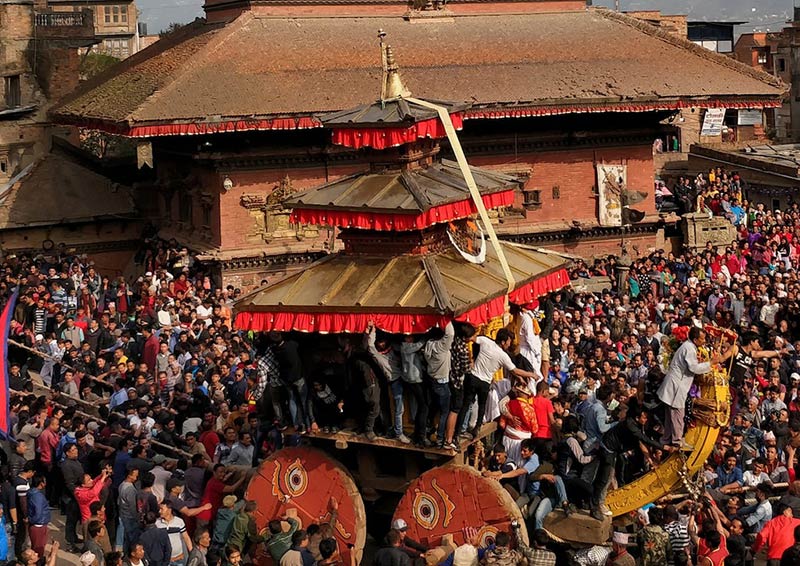
Nepal celebrates other festivals too which are not aforementioned. All festivals are equally important and hold great historic and cultural connotations. Some of the other festivals are Guru Purnima, Gai Jatra, Haritaalika Teej, Eid, Rishi Panchami, Krishna Janmashtami, Janai Purnima/ Raksha Bandhan, Udhauli Parva/Yomari Punhi, Christmas, Basanta Panchami, & Ghode Jatra.
Updated: May 15,2023


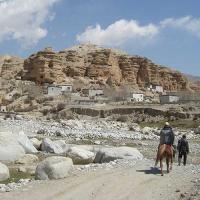
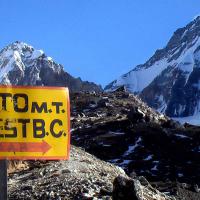
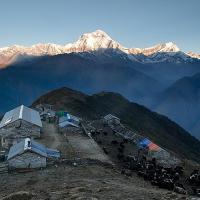
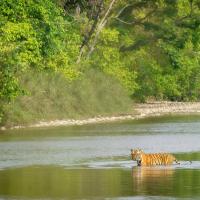
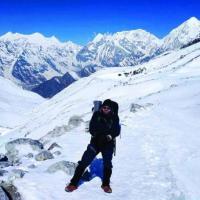
Post your comment